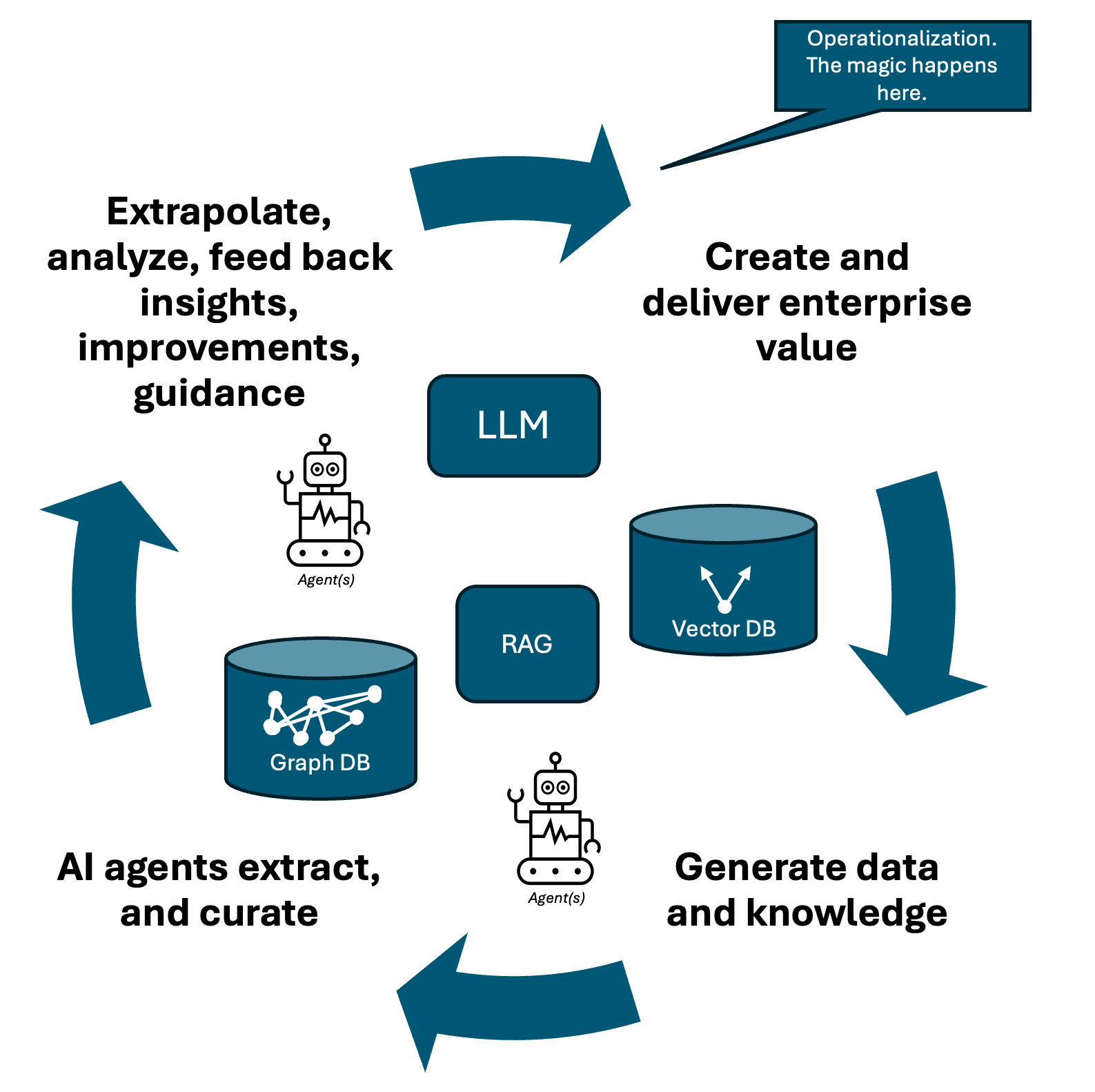AI Wakes The Sleeping Giant: Continuous Improvement Will Finally Fulfill Its Promise
The enterprise world is on the brink of a fundamental transformation, and I believe we’re underestimating just how deep it will go. Over the past month, I’ve had a series of epiphanies about generative AI, knowledge graphs, and AI agents. What I’m now seeing is a reinvention of one of management’s most foundational practices: continuous learning and improvement.
The classic continuous improvement models such as Deming and Juran were meant to drive cycles of progress through measurement and feedback and, in the broad history of management, were enormous contributions to progress. But let’s be honest: In too many organizations, they devolved into bureaucratic rituals. Continuous improvement became a department, a toolbox, not a way of working and being. Feedback loops broke. The data was stale. The insights, pro forma and shallow. The excitement, gone.
That changes now.
Unlocking Your Knowledge Is Finally Possible
We are seeing the reemergence of continuous learning and improvement at enterprise scale but, this time, fueled by AI, operationalized through agents, structured in graphs, and enriched with live telemetry.
Imagine the modern enterprise as an organism constantly producing digital exhaust: transactions, reports, artifacts, documents, source code, logs, alerts, collaboration threads, service tickets. Far from being waste, this exhaust holds untold potential to fuel innovation, growth, and continuous learning. For decades, though, we lacked the means to turn this torrent of information into coherent, trustworthy, operationalized knowledge. Knowledge management tried to harness it but struggled under the weight of manual curation, siloed formats, and weak engagement.
With the convergence of genAI, retrieval-augmented generation (RAG), knowledge graphs, and autonomous agents, we stand at the edge of a new era.
Why It Works Now
The new feedback loop is radically different. It looks like this:
- Enterprise operations continue as they always have: massive estates of digital and physical complexity.
- They generate data and information: records of activity, structured or unstructured.
- Harvester AI agents (empowered by large language models [LLMs]) observe and interpret the information in real time and structure and curate it into a semantic graph. Connected, unstructured information is translated into embeddings in a vector store.* They monitor for quality, semantic drift, alignment gaps, emergent patterns, and unknown unknowns, feeding raw data into LLMs for synthesis and analysis.
- Operational agents continuously analyze the graph and vectors, comparing new information with previous, making the knowledge alive and actionable — and feeding it back to step one.
And unlike human analysts, agents don’t get tired. You can have dozens running, constantly surfacing insights, looking for contradictions, comparing past patterns with current anomalies, and suggesting actions. They aren’t replacing judgment — they’re finally making relevant, continuous feedback real. The control and improvement of these agents will be a significant task; humans will work with TuringBots (LLM-based coding engines) to evolve them continuously.
This Isn’t Just About IT
To be clear, this applies well beyond IT. The IT industry — where Forrester has documented the rise of a new control plane architecture — and its telemetry is already rich and digitized, therefore well suited to reap these new benefits. Vendors such as ServiceNow, Atlassian, and Wiz are already implementing large-scale graphs. But every function in the enterprise can start moving toward graph-driven, agent-enabled learning: sales, marketing, R&D, HR, finance, risk, supply chain, customer service, etc. Any domain that produces traceable work can benefit.
Why Graphs Are Essential
It’s tempting to think that LLMs alone can solve this. But we’re finding that, without structure, genAI alone drifts. The graph is essential. It is the skeleton to the LLM’s flesh. Graphs allow agents to:
- Track dependencies across domains.
- Represent evolving relationships (versioned capabilities, changing ownership, dynamic markets).
- Identify semantic similarity and drift.
- Enable reasoning over time.
We can stop treating knowledge management as a static repository and instead see it as a living, navigable, self-healing system. Systems thinkers know that there is nothing more powerful than a true reinforcing (“positive”) feedback loop. I believe this is now forming, and major new feedback loops in the economy don’t appear all that often — the “network effect” observed in the early internet days is the most obvious comparison. Yes, there will be balancing dynamics: security, privacy — but most of what I am talking about here can take place within the boundaries of an enterprise, assuming that it can afford to run its own large-scale LLMs. There will be many experiments. Are the agents acting as advisors? Regulators? Traffic cops? Auditors? Judge and jury … ? People are going to try all of these. (We’ll need responsibility assignment tools for agents … agentic decision rights, to coin a new term, will be a new business analysis challenge.)
Implications For The Enterprise
- Enterprise architects and CIOs must rethink knowledge systems not as forms-based or document-centric but as graph-centric, with unstructured information a first-class operational citizen, all with continuous agent interaction.
- Vendors must offer agent-integrated platforms that allow customers to define, extend, and control their semantic models.
- Venture capitalists, acquirers, and enterprise customers should look for graph-native architectures and agent ecosystems in their due diligence, as well as LLMs and RAG.
- Knowledge governance must evolve to accommodate autonomous curation, semantic versioning, and feedback validation.
- Every operating model needs a feedback loop that includes telemetry capture, AI interpretation, graph enrichment, and agent-led action.
The Historical Parallel
You have to go back to the early 20th century — to the creation of the modern corporate operating model at General Motors and DuPont — to find a change this significant. Back then, accounting and management science reshaped industrial capitalism. I believe that genAI, agents, and graphs will have comparable impact on digital capitalism.
It’s time to move beyond the brittle forms of continuous improvement we inherited from midcentury management. Let’s reclaim its spirit and deliver on its promise, with tools that can finally make it real.
The new feedback loop is not a theory. It’s starting to happen. Will your organization lead or follow?
*And the graph itself can have vector embeddings, but I’ll save that rabbit hole for the footnote. I’ve been doing some hands-on work with all these technologies, and one of the most interesting revelations was giving an unstructured snippet of text to a large language model and having it create a precise database update query — what the academics might call natural language processing or entity extraction, at a practical, operational level. Clearly, there’s opportunities for bad data quality, etc., but that’s just as possible with human operators. We’ll have to put in controls and guardrails, after-the-fact exception checking … all the data quality stuff. But we’ll have tireless agents looking after the integrity of the data.

